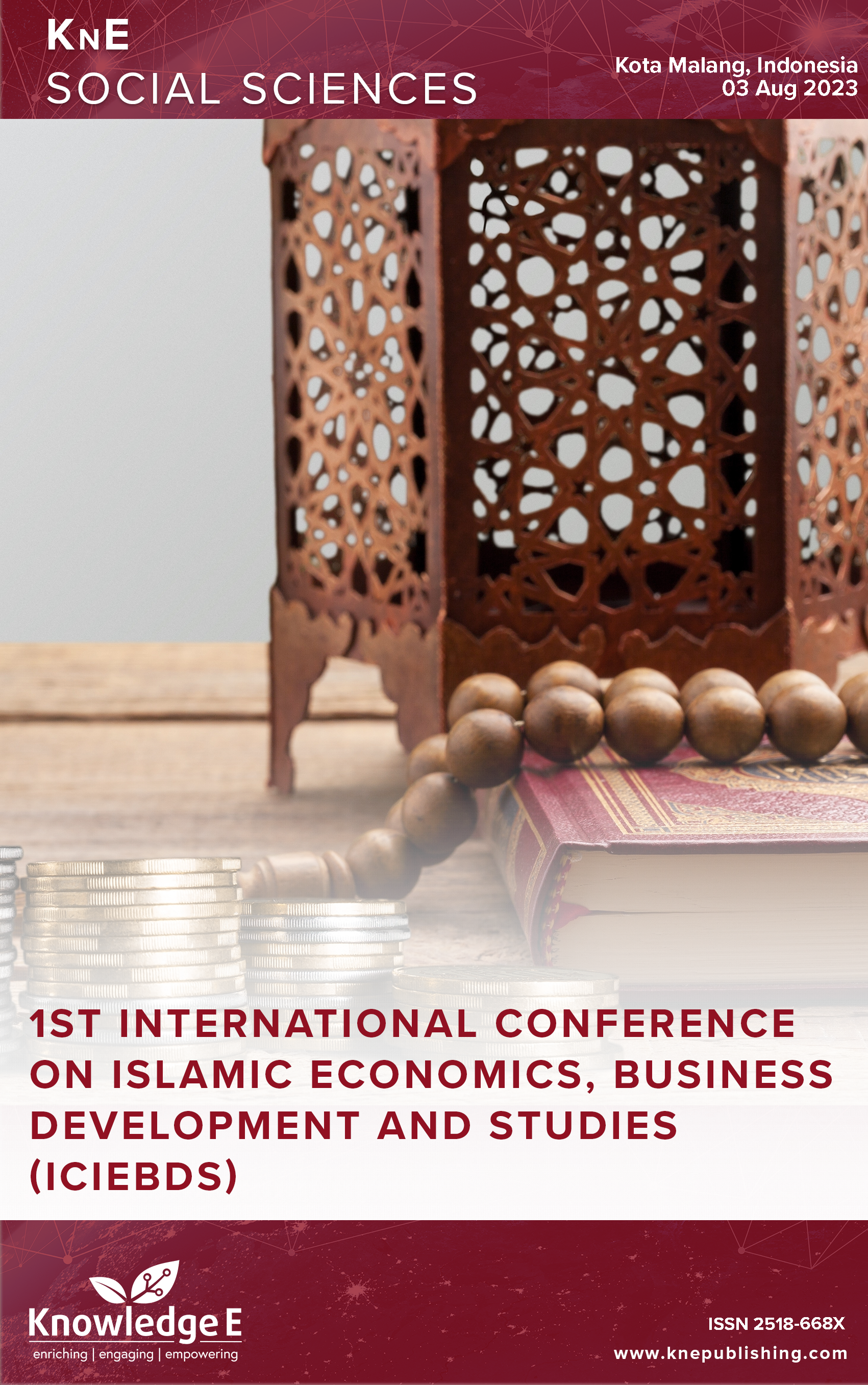Spatial Analysis of the Effect of Halal Product Export and Import on Current Accounts in OIC Countries
DOI:
https://doi.org/10.18502/kss.v9i16.16237Abstract
OIC countries are countries that have the highest development of the halal industry. Most of the export and import activities carried out by OKI are halal products. Exports and imports of the country’s halal products will describe the condition of the current account surplus or deficit. This study aims to determine the spatial dependence on the current account and the effect of exports and imports of halal products on the current account. The method used descriptive quantitative techniques with spatial analysis. This research was conducted in 51 OIC countries in 2021 using secondary data. The independent variable values are obtained from ITC and the dependent variable is obtained from WDI. The results showed that there is a spatial autocorrelation in the current account, and the spatial autoregressive regression (SAR) results show that exports of halal products have a significant positive effect on the current account. Meanwhile, imports of halal products have a negative but not significant effect on the current account.
Keywords: spatial, halal export, halal import, current account balance
References
DinarStandard, “State of Global Islamic Report 2022,” DinarStandard.
Eun Kyeong YU, Hee-Yul LE, Dong-Hwan KI. “Is Halal Certification Necessary for Exporting to Islamic Countries? Focus on OIC Countries,” cult. int. J. Philos. cult. Axiology. 2020;17(1):173–92. DOI: https://doi.org/10.3726/CUL012020.0011
Azam MS, Abdullah MA. “GLOBAL HALAL INDUSTRY: REALITIES AND OPPORTUNITIES,” int. J. Islam. buses. Ethics. 2020 Mar;5(1):47. DOI: https://doi.org/10.30659/ijibe.5.1.47-59
Nadeer Al Jallad. The concept of al-halal and al-haram in the Arab-Muslim Culture: a translational and lexicographical study. Jordan: Univ.; 2008. pp. 77–86.
M. Gul, J. Akbar, M. Ikramullah, and MH Khan, “A Research Overview of Challenges in The Global Halal Market”.
Sutan Emir Hidayat, Ahmad Rafiki, and Muhammad Dharma Tuah Putra Nasution, “Halal Industry’s response to a current and post-COVID -19 landscape and lessons from the past,”J. Islam. mark., 2021, https://doi.org/10.1108/JIMA-06-2020-0180. DOI: https://doi.org/10.1108/JIMA-06-2020-0180
Maya Adiba E. “CONSUMER PURCHASING BEHAVIOR OF HALAL COSMETICS: A STUDY ON GENERATIONS X AND Y,”J. Islam. Monet. Econ. Finance. 2019 May;5(1):169–92. DOI: https://doi.org/10.21098/jimf.v5i1.1052
Nurrachmi R. The Global Development of Halal Food Industry: A Survey. Islamic Tazkia. Finance Bus. Rev. 2018 Mar;11(1): https://doi.org/10.30993/tifbr.v11i1.113. DOI: https://doi.org/10.30993/tifbr.v11i1.113
Susilawati C. “The Role of the Halal Industry in Recovering the National Economy in the Covid-19 Pandemic,”int. J. Nusant. Islam. 2020 Dec;8(2):202–14. DOI: https://doi.org/10.15575/ijni.v8i2.10807
Zubaid NL. “Indonesian Export Diversification to OIC Countries during Covid-19 Pandemic: A Literature Review,” vol. 5, no. 2, 2023. DOI: https://doi.org/10.17509/rief.v5i2.51763
Gozgor G. Causal Linkages among the Product Diversification of Exports. Turkey: Economic Globalization and Economic Growth; 2017. DOI: https://doi.org/10.1111/rode.12301
NHN Azman, “Halal Development and Food Exports: Evidence from Malaysia and MEACs,” 2012.
Guidelines for Certifications of Halal Meat Products. New Delhi: Department of Commerce Directorate General of Foreign Trade; 2023.
Statistical Yearbook on OIC Member Countries 2020. Ankara, Turkey: SESRIC; 2021.
“Top exporters of halal foods to OIC countries worldwide in 2021.” https://www.statista.com/statistics/785151/top-exporters-of-halal-food-global/
Yazid F, Kamello T, Nasution Y, Ikhsan E. “Strengthening Sharia Economy Through Halal Industry Development in Indonesia,” inProceedings of the International Conference on Law, Governance and Islamic Society (ICOLGIS 2019), Banda Aceh, Indonesia: Atlantis Press, 2020. https://doi.org/10.2991/assehr.k.200306.187. DOI: https://doi.org/10.2991/assehr.k.200306.187
Shafi, Khuram, Liu Hua, Zahra Idrees, and Amna Nazeer, “Impact of Change Rate, Inflation Rate and Interest Rate on Balance Payment : A Study from India and Pakistan,” vol. 3(1), pp. 9–13, 2015.
Apergis N, Katrakilidis C, Tabakis N. “Current Account Deficit Sustainability: the Case of Greece,”appl. Appl Econ Lett. 2000;7(9):599–603. DOI: https://doi.org/10.1080/13504850050059087
Candra CS, Adrian J, Lim VC. “Indonesian Trade Deficit with China: Background and Gray Forecasting,”int. J. Gray Syst. 2021 Dec;1(2):33–46. DOI: https://doi.org/10.52812/ijgs.15
Polyak P. The silent losers of Germany’s export surpluses. How current account imbalances are exacerbated by the misrepresentation of their domestic costs. Comp Eur Polit. 2022;(Apr): https://doi.org/10.1057/s41295-022-00291-8. DOI: https://doi.org/10.1057/s41295-022-00291-8
Noraditha Y, Heriberta H, Emilia E. “Analysis of variables affecting the performance of Indonesia’s current account balance for the period 2006-2020,”EJ. Trader. ind. Dan Monet. 2022 Mar;10(1):51–62. DOI: https://doi.org/10.22437/pim.v10i1.15846
Bagaskoro MN. EXPORT IMPORT EFFECT ON INDONESIAN CURRENT TRANSACTIONS BEFORE AND AFTER SUBPRIME MORTGAGE. ECOPLAN J. Econ. Dev. Studs. 2019 Apr;2(1):21–32. DOI: https://doi.org/10.20527/ecoplan.v2i1.15
Purnama WA, Auwalin I. The Influence of Exports of Halal Products on Current Account Balance in Indonesia. J. Ekon. Sharia Theory And Application. 2020 Jan;6(6):1242. DOI: https://doi.org/10.20473/vol6iss20196pp1242-1258
Syamsuri N, Masrifah AR. Halal Industry Products Influence on Current Account in OIC Economics in Asia on 2015-2019. J. Ilm. Econ. Islam. 2022;8:3401–11. DOI: https://doi.org/10.29040/jiei.v8i3.5407
Todaro, MP. Smith (SC): Economic Development; 2011.
Madura J. International Finance Management, 9th ed. South Western: Thomson, 2008.
Hou S, Li Y. “Empirical Analysis of the Influence Factors of China’s Current Account Surplus,” inProceedings of the 2017 5th International Education, Economics, Social Science, Arts, Sports and Management Engineering Conference (IEESASSM 2017), Qingdao, China: Atlantis Press, 2018. https://doi.org/10.2991/ieesasm-17.2018.90. DOI: https://doi.org/10.2991/ieesasm-17.2018.90
AR Masrifah, “Halal Industry Products influence on Current Accounts in OIC Economics in Asia on 2015-2019”.
Wahyu Puji Astuti. Export and import. Semarang: Literary Pearls; 2019.
Adrian Sutedi,Import export law. in 1. jakarta: Achieving Hope for Success, 2014.
Sri Herianingrum N. The Influence of GDP, Exports and Investment on Inflation in Five IDB Member Countries. J. Ekon. 2020 Mar;25(1):81. DOI: https://doi.org/10.24912/je.v25i1.628
Arif S. Food quality standards in developing quality human capital: an Islamic perspective. Afr J Bus Manag. 2011 Dec;5(31): https://doi.org/10.5897/AJBM10.1692. DOI: https://doi.org/10.5897/AJBM10.1692
Bryan A. Social Research Method. New York: Oxford University Press; 2012.
Anselin L. “Lagrange Multiplier Test Diagnostics for Spatial Dependence and Spatial Heterogeneity,”geogr. Geogr Anal. 2010 Sep;20(1):1–17. DOI: https://doi.org/10.1111/j.1538-4632.1988.tb00159.x
Lee SI. Developing a bivariate spatial association measure: An integration of Pearson’s r and Moran’s I. J Geogr Syst. 2001 Dec;3(4):369–85. DOI: https://doi.org/10.1007/s101090100064
Cavanaugh JE, Neath AA. “The Akaike information criterion: Background, derivation, properties, application, interpretation, and refinements,”WIREs Comput. Wiley Interdiscip Rev Comput Stat. 2019 May;11(3):e1460. DOI: https://doi.org/10.1002/wics.1460
“Annual Report On Trade Among The OIC Member States Executive Summary,” Istanbul-Turkey.

